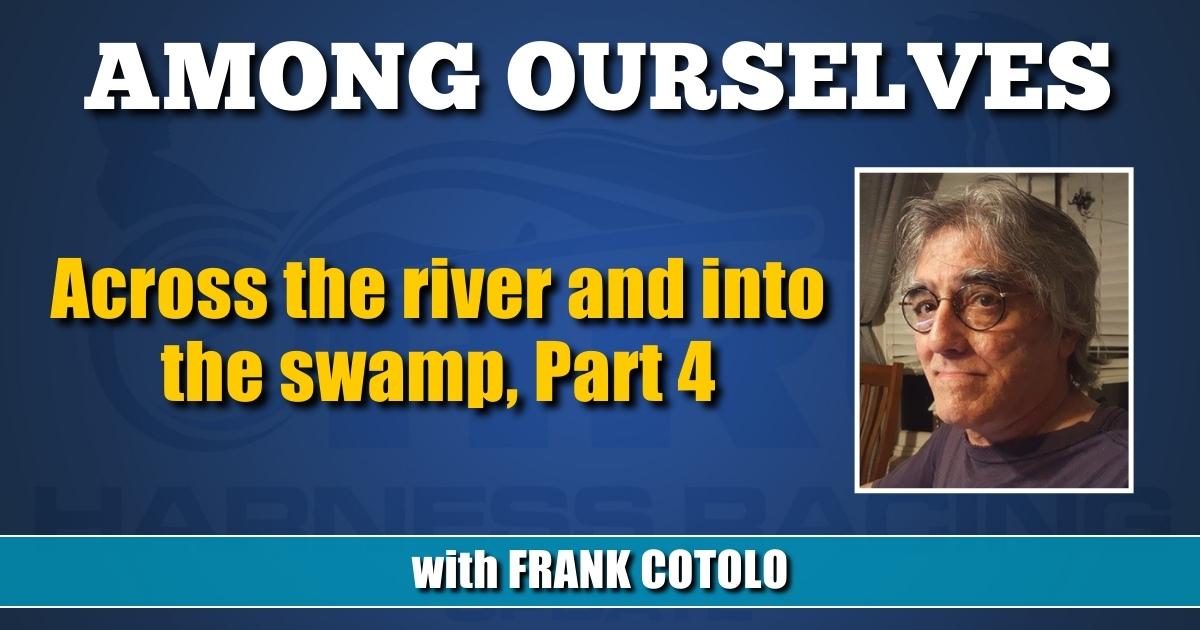Across the river and into the swamp, Part 4
by Frank Cotolo
Part 1 is here.
Part 2 is here.
Part 3 is here.
Del Insko was a major New York-circuit harness horsemen and he knew just about everyone in the business and that made him a valuable contact for people interested in standardbred ownership.
Like Mal Burroughs. Burroughs talked to his accountant about owning a standardbred and what do you know, his accountant knew another accountant with a client by the name of Del Insko.
“I had lunch with [Insko] and I liked what I heard,” Burroughs said. “After that meeting I decided to get involved.”
Insko gave Burroughs a lead on a yearling selling at a Tattersalls mixed sale. Burroughs went to Kentucky and purchased the horse, Distant Thunder, for $24,500.
“I told Del I was going to take the yearling to my farm and see if I could break it and train it,” Burroughs said.
Distant Thunder, Burroughs said, was an experiment. He read James Harrison’s book on care and training and worked eight months learning skills.
“I got him going pretty well,” he said, “but he wasn’t right. Someone put me in touch with Doc Steele and he told me the horse had calcium in a knee and the worst thing for that was cold weather.”
According to Burroughs, Steele recommended shipping the horse to Florida “to [Bill Vaughan] who started his own public stable.”
Distant Thunder raced well at 3 and he was second in a heat of the Jug.
“And he chased Abercrombie around all year and made about $180,000,” Burroughs said. “I raced him at 4 and then he went to stud in New Jersey.”
Then, more experimenting. Burroughs bought Satin Doll for $38,000 and the pacing filly became a top performer. He bought more yearling pacers and broke and trained them. But Vaughan loved trotters. He said trotting is where horsemen make real money. Fine, but Burroughs was flirting all along with another means of participation in the sport.
“The whole driving thing started with a filly in the Jugette,” Burroughs said. “Billy Haughton cared for her. We got rained out one day, the grooms were gone and Billy wanted to get the horses moved. ‘Take your filly and jog it.’”
Haughton told Vaughan to teach Burroughs.
“I always thought Joe O’Brien was the coolest driver out there,” Burroughs said. “Driving like him was my goal.”
Owning, training, driving and then breeding kept him in the game financially but he “wanted to go the next step: breed my own horse, raise the foal myself and drive it…” Burroughs said. “I studied breeding, read every theory so I was able to figure what crosses with what best.”
Burroughs met Jimmy Takter and the duo bred, broke and trained Burroughs’ first successful trotter, a filly, Gleam. Burroughs was still an amateur in the bike when he drove her to win the Hambletonian Oaks. By that time, the track that Burroughs helped build was the center of the harness racing industry and home of the Hambletonian.
It was Burroughs’ next goal.
“I want the big one,” he said.
Malabar Man was the first horse foaled on Burroughs’ farm. Takter loved how the Supergill colt developed.
“He’s a perfect horse,” Takter said.
But the summer of ‘95 was cruel. Malabar Man fell ill and Burroughs had a serious heart attack. By autumn ‘96, Burroughs and his colt defied adversity. At 2, Malabar Man won the Breeders Crown. He returned at 3, amateur Burroughs steering, and there I was at The Meadowlands covering the 1997 Hambletonian.
A decade and a few years later I covered The Hambletonian at The Meadowlands for the Hambletonian Society and TwinSpires dot com. My new assistant was Ray Cotolo, my youngest son. We were on our way out of the hotel when the elevator stops and in walks Burroughs. I reminded him I was an editor at TIMES: in harness and introduced him to Ray.
“Ray, this is the man who built The Meadowlands, I mean not all by himself,” I said. “Remember I told you about Malabar Man?”
“Yeah,” Ray said.
Burroughs said hello and was polite and calm and looked healthy. I told him that one of the best driver-related quotes I ever received came from him, only the second amateur driver to win a Hambletonian.
“I told Ray what you said a great driver does,” I said. “You remember you told my readers, ‘I think it’s very simple. Never win by more than you have to.’”
In 2004, Malabar Man went to stud at New York’s Winbak Farm. He died in 2011, the year the original Meadowlands grandstand, across the river from the once-hallowed half-miles of New York, shut down. The track was privatized and purchased by real-estate giant Jeffrey Gural’s Newmark Knight Frank. The current grandstands and racetrack were built on the site of the former backstretch. It opened in 2013.
“For of no right, nor color like to right, he fills fields with harness in the realm.” ~Shakespeare, King Henry IV.
















